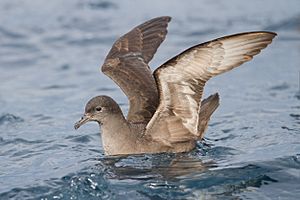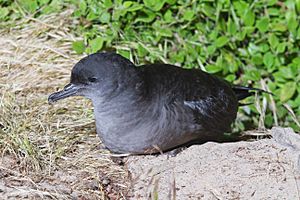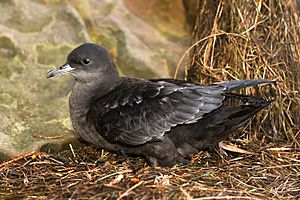Short-tailed shearwater facts for kids
Quick facts for kids Short-tailed shearwater,Slender-billed shearwater |
|
|---|---|
 |
|
| Conservation status | |
| Scientific classification | |
| Genus: |
Ardenna
|
| Species: |
tenuirostris
|
 |
|
The short-tailed shearwater (Ardenna tenuirostris) is a special type of seabird. It's also known by other names like slender-billed shearwater, yolla, or moonbird. In Australia, many people call it the muttonbird. This bird is very common in Australian waters. It's one of the few native Australian birds whose young chicks are collected by people for food and oil.
This bird is a migratory species. This means it travels long distances every year. It builds its nests and raises its young mainly on small islands in places like Bass Strait and Tasmania. When summer arrives in the northern part of the world (the Northern Hemisphere), the shearwaters fly all the way there. They spend the northern summer feeding in cooler waters before returning south.
Contents
About the Short-tailed Shearwater
The short-tailed shearwater is related to other birds like the sooty shearwater and the great shearwater. These birds all have blunt tails and black beaks. Scientists have studied their DNA to understand how they are related. They found that these larger shearwaters belong to their own special group, called Ardenna.
How Short-tailed Shearwaters Raise Their Young
Short-tailed shearwaters lay just one egg. Both parent birds take turns feeding their single chick for a few days. Then, they might leave the nest for up to three weeks to find food. These food-finding trips can be very long, sometimes covering over 1,500 kilometers (about 930 miles)! This means the chick might be left alone for more than a week.
When the young birds are ready to leave the nest, they are called fledglings. They can weigh around 900 grams (about 2 pounds), which is sometimes even heavier than their parents! The largest group of these birds in the world, about 2.8 million pairs, lives on Babel Island in Tasmania.
Dangers for Young Shearwaters
Sometimes, adult shearwaters mistake plastic floating in the ocean for food. They accidentally eat this plastic and then feed it to their chicks. This plastic, along with other things, can make the chicks sick.
When young shearwaters take their first flight from their nests to the ocean, bright artificial lights can confuse them. Thousands of these young birds are attracted to the lights. They might crash into buildings or other human structures. If they land on the ground, they can get hurt, or become easy prey for other animals, or even get hit by cars.
The Amazing Migration Journey
Every year, when it's winter in the southern part of the world (austral winter), the short-tailed shearwaters fly north. They travel to the seas near the Aleutian Islands and the Kamchatka Peninsula. When spring arrives in the southern hemisphere, they fly back. They travel down the coast of California and then cross the huge Pacific Ocean to return to Australia. This long journey helps them find food and good places to raise their young.
The Muttonbird Harvest
The name "muttonbird" was first used by early settlers on Norfolk Island. They used to collect a different bird, the Providence petrel, for food. These petrels were similar to shearwaters but bigger. Someone from the Royal Marines even called them "the flying sheep" because they were harvested like sheep.
A Long Tradition of Harvesting
For many generations, Tasmanian Aborigines have collected muttonbirds and their eggs. This is a very important cultural practice for many families, and they continue it today. The muttonbird is one of the few native Australian birds that people are allowed to harvest for commercial reasons.
During the muttonbird season, young chicks are collected for their feathers, meat, and oil. This industry was started a long time ago by early European sealers and their Aboriginal families. If people want to collect muttonbirds for fun, they can only do so during a special open season each year. They also need to get a special license to do it.
Images for kids
See also
 In Spanish: Pardela de Tasmania para niños
In Spanish: Pardela de Tasmania para niños





